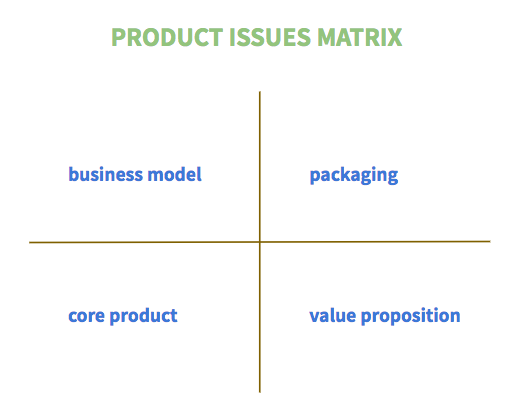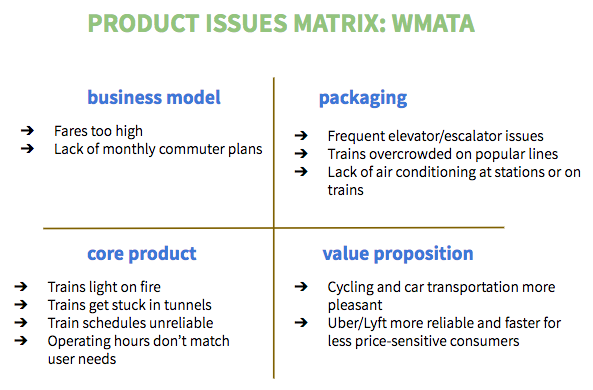The DC Metro system is an unenviable product to have to fix. For years, the system was reliably unreliable and could be a downright unpleasant experience even when it was supposedly functioning as normal: delays, outages, overcrowding during rush hour, and a lack of air conditioning on trains during DC’s blistering hot summers were all par for the course.
The Metro’s problems are so bad that there’s a Twitter account called UnsuckDCMetro and a podcast called MetroPocalypse. The problems peaked in 2015 when smoke filled a tunnel, injuring several riders and killing a woman. Facing a unreliable, unsafe infrastructure and a complete collapse in public trust, Metro brought in a new General Manager in early 2015 tasked with turning around the system.
Metro is an extreme example of a product with issues. While most of us will probably never face a product with this magnitude of issues, it’s a useful example for illuminating a framework that can be used to fix a product. If you’re inheriting an existing product and have the mandate to fix it, it can be difficult to know where to start. And, similarly, if you’ve recently launched a product and it isn’t performing as expected, there might be a myriad of different things contributing to its underperformance. Organization and prioritization are key to fixing a product, and that’s where a framework can be helpful.
That’s where the Product Issues Matrix comes in: a simple framework that is effectively a product-focused version of the Business Model Canvas.

Each quadrant deals with a unique set of issues that are important for product success: the business model, the core product, the packaging, and the value proposition.
- Business model: This quadrant deals with commercial mechanisms that are highly relevant to product success but irrelevant to the solution being delivered (and thus more easily tested or tweaked) are potential sources of trouble.Areas to investigate in this quadrant include price point, pricing model, refund/cancellation policy, user acquisition costs, and etc.
- Core product: This the core problem being solved for the user and how you are solving it. What are the problems you assumed existed in the market? Do you need to do additional validation of high-risk assumptions? Do you understand the problem to be solved, and are you delivering the right solution? If you think you’re delivering the right solution, is the solution complete? Have you misunderstood the activities the user is trying to accomplish and delivered the wrong set of tools to accomplish those activities?
- Packaging: This is how the user interacts with the solution. Potential issues here include: usability, incomplete application of relevant user mental models, the interface not conveying the value of the solution, or a lack of tools that support the key activities of the user.
- Value proposition: This is your messaging around the product and how the product is delivering on that messaging. Are you speaking to — and delivering on — the user’s underlying goals? If refunds/cancellations are higher than expected, has your marketing created an expectation that the product doesn’t fulfill? If acquisition is lagging, have you misjudged the size of the market, or framed the messaging with the wrong user goals?
Single-Tracking a Complicated Set of Issues
Returning to the Metro example, here’s what its Product Issues Matrix might look like:

Using the framework as an opportunities matrix
On the flip side, the matrix could also be used to evaluate a potential product opportunity. Outlining a product idea using the matrix could help you realize that you’re building a product that only solves one of the key issue areas — and prioritize testing whether your differentiation in that area, most commonly price or packaging, is strong enough to drive a viable product.
For example, streaming music companies have generally differentiated themselves compared to other music delivery methods by ease of use: Spotify is more convenient than CDs, and more cost-effective than downloading songs from iTunes. Yet despite those packaging improvements, Spotify faces significant troubles as a company since royalty fees (Core Product) significantly eat into its revenue.
From mental model to stakeholder engagement
In the case of Metro, the complete picture of the system’s problems took the form of an 89-page report from McKinsey. It deep-dives in almost a dozen different areas, yet I’d argue that it lacks an easily-graspable narrative. Diagnosing issues is only the first step of fixing a product — the next, and just as important step — is to clearly communicate the problems and what you plan to do about them, often to people who spend far less time thinking about the product than you do. That’s where a clear framework like the Product Issues Matrix can come into play: not only giving you a mental model for the issues, but your stakeholders as well, and can kick off discussions focusing on the different areas. Which quadrant is the most important among your stakeholders? Have previous efforts focused on one quadrant to the detriment of others? Having a common starting point with shared lexicon is half the battle. Ultimately, if you can get people speaking the same language, it’s a lot easier to move the ball forward. Or the train, in this case.